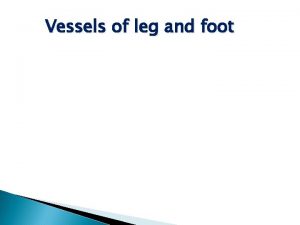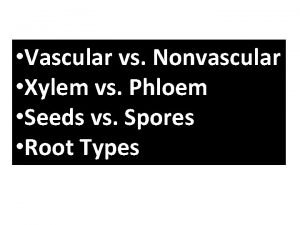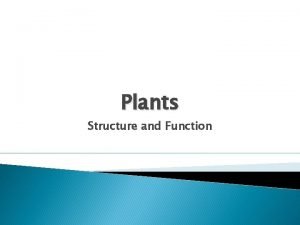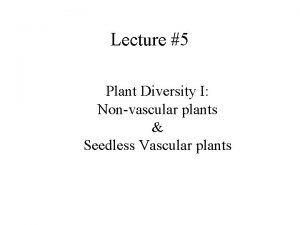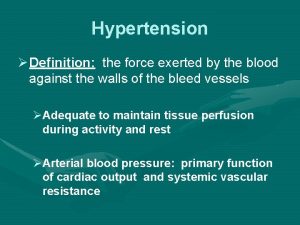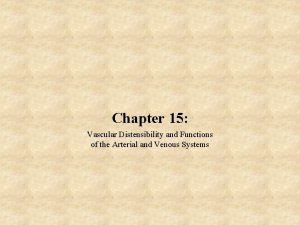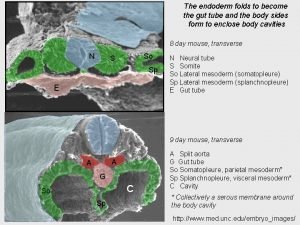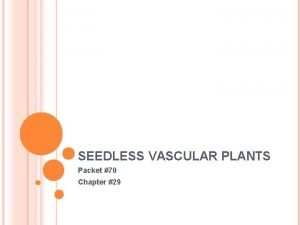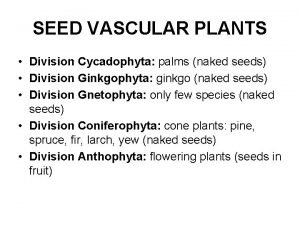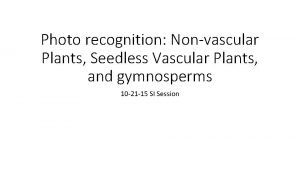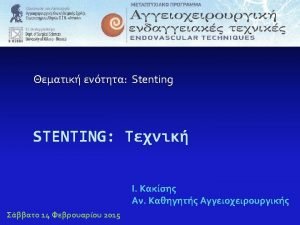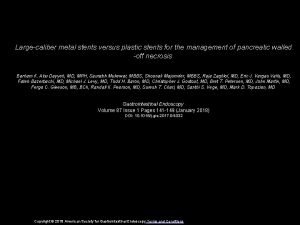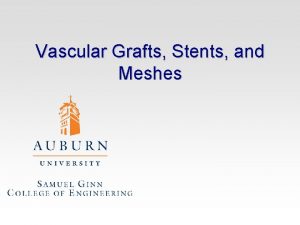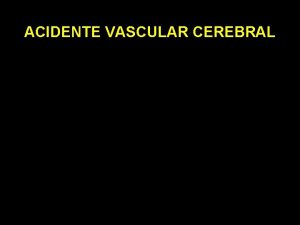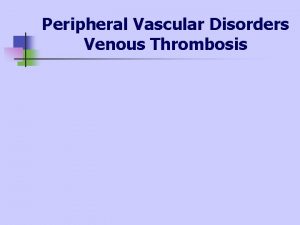Impact of Stents Vascular stents have made it






































































- Slides: 70


Impact of Stents Vascular stents have made it possible to reline a diseased artery Stents have had a major impact on the development of endovascular surgery that is manifested in four ways

Impact of Stents 1. The complications of balloon angioplasty, such as dissection and residual stenosis, may be immediately treated 2. Lesions that otherwise would have required open surgery, such as occlusions or long lesions or recurrent stenoses, may be treated with endovascular surgery 3. The overall spectrum of arterial lesions that can be approached with endovascular techniques has broadened dramatically 4. Combining stents with graft material to create covered stents has permitted the endovascular treatment of more advanced disease

Impact of Stents Each stent application has its own cost and complication risks the sheath must usually be upsized a foreign body is implanted the procedure time is often extended somewhat stents have their own unique complications

Impact of Stents The cost of a single stent substantially increases the cost of an endovascular intervention The placing of stents may be motivated by the wish to extend the short- or long-term success of balloon angioplasty to avoid surgery to avoid repeat balloon angioplasty Ø But should be considered in each case !!

Impact of Stents Future applications of stents may include further miniaturization the ability to release antithrombotic agents emit irradiation prevent intimal hyperplasia through bioengineering design changes

Type of Stents are either balloon-expandable or -expanding The Wallstent is a special flexible self-expanding, wire mesh tube self

Type of Stents The balloon-expandable stent design This is a straight, metal, rigid, and balloon-expandable cylinder The stent is premounted onto a standard angioplasty balloon It is deployed when the balloon is inflated

Type of Stents The balloon-expandable stent design The rigid balloon-expandable stent has excellent hoop strength but can be crimped by external forces

Type of Stents The balloon-expandable stent design Perform best when placed in locations that have no mobility Perform best when they are relatively short in length since they are rigid Shorten slightly as they expand in diameter Most renal artery stents are between 1 and 2 cm, and most iliac stents are 3 to 4 cm These are the places where balloon-expandable stents are most useful

Type of Stents The self-expanding stent design More commonly constructed of Nitinol, a nickel-titanium alloy Have thermal memory and a high degree of contourability Are packaged on their own delivery catheters Are deployed by retracting the covering sheath

Type of Stents The self-expanding stent design Maintain continual outward radial force after deployment Are not as susceptible to damage from external forces since they are more flexible Have much less hoop strength

Type of Stents The self-expanding stent design are intentionally oversized at the time of deployment in the artery, usually by 2 to 3 mm cover more distance are more difficult to place with great accuracy

Type of Stents Balloon-expandable Self-expanding Wallstent

Type of Stents

Type of Stents Self-expanding and balloon-expandable stents tend to play complementary roles Deciding which type of stent to use may be somewhat subjective from one practice to another Endovascular specialists must become facile with the use of each of these two general stent types In addition, there are numerous stents, both balloonand self-expanding, that are available

Indications for Stents Primary stent placement the operator knows ahead of time that a stent will be placed Selective stent placement the selective approach where the operator must decide during the procedure

Indications for Stents The concept of primary stent placement presupposes that the patient is better off with a stent, regardless of the results of treatment of the lesion with balloon angioplasty alone Appears to work best for some lesions that were treated with balloon angioplasty alone in the past with marginal to mediocre results, including recurrent lesions, occlusions, orifice lesions, and others renal artery origin lesions carotid bifurcation aortoiliac occlusive disease

Indications for Stents The idea behind primary stent placement is that the short- and/or long-term results are generally improved with stent placement to the point where it justifies the up-front increase in risk and cost Taken to its fullest extent, however, every lesion in every patient would receive a stent, and this would be expensive and unnecessary

Indications for Stents Reasonable long-term results with balloon angioplasty for many aortoiliac, infrainguinal, nonorifice renal lesions, and some upper extremity lesions The concept of selective stenting. Balloon angioplasty is performed. The results are assessed. If the results are not acceptable, stent placement is performed residual stenosis persistent pressure gradient significant dissection

Indications for Stents The temptation with stents is to continue to lay them in place until the entire arterial tree appears to be perfect The “stack of stents” phenomenon should be avoided

Which Lesions Should Be Stented? Although each specialist must decide what the appropriate level of stent placement aggressiveness is, there are specific situations where stents are useful, or even obligatory

Which Lesions Should Be Stented? Post-angioplasty dissection Stent placement should be considered for any significant dissection after angioplasty, even if there is no gradient Stents should be placed for any false channel or for any intimal flap that impede flow, increase in size during the procedure, or extend into a previously uninvolved segment of artery

Which Lesions Should Be Stented? Residual stenosis after angioplasty The concept of preventing recurrence by eliminating residual stenosis makes empiric sense A 30% postangioplasty stenosis is used as a general threshold for continued intervention

Which Lesions Should Be Stented? Pressure gradient A pressure gradient (>10 mm Hg systolic) after angioplasty usually indicates a residual stenosis or dissection that requires treatment The threshold for treatment is somewhat arbitrary

Which Lesions Should Be Stented? Recurrent stenosis after angioplasty Treating recurrence with stent placement after previous angioplasty is an empiric approach with reasonable results

Which Lesions Should Be Stented? Occlusion Balloon angioplasty alone for occlusions has only fair results and these may be improved with stent placement Stent placement may make the procedure safer by stabilizing residual thrombus that could embolize from the lesion site, especially if covered stents were used Stent placement in the treatment of iliac and superficial femoral artery occlusions is widely accepted

Which Lesions Should Be Stented? Embolizing lesion Stent placement at the site of an embolizing lesion is thought to trap the embologenic plaque and prevent further embolization during intervention. The use of covered stents could be considered in such cases

Which Lesions Should Be Stented?

Placement Techniques Balloon-Expandable Stents

Placement Techniques: Balloon-Expandable Stents The selection of the diameter is an important decision in the placement of balloon-expandable stents The stent size is selected based on the anticipated diameter of the reconstructed artery If the selected stent is too small in diameter, it may not adhere to the vessel wall after deployment and could migrate If the stent is too large, it will overstretch the artery and may cause rupture

Placement Techniques: Balloon-Expandable Stents If selective stent placement is performed, the inflated balloon profile from the initial angioplasty may be used to size the artery When primary stent placement is performed, sometimes it is necessary to dilate the lesion with the balloon alone to size the lesion and to create enough space for the stent delivery catheter to be placed across the lesion

Placement Techniques: Balloon-Expandable Stents Balloon-expandable stents can be dilated a few millimeters larger than the intended specifications But as the diameter increases, the length decreases The shortest stent that covers the lesion (usually 1– 4 cm) is placed Longer balloon-expandable stents are available (up to almost 8 cm) but there are disadvantages to the rigidity of these stents over longer distances. They do not conform to any tortuosity or any change in vessel diameter along the length of the stent.

Placement Techniques: Balloon-Expandable Stents Most premounted ballon-expandable stents can be placed using a 6 -Fr sheath Larger vessel stents, such as that used for large iliacs up to 12 mm are placed through larger sheaths

Placement Techniques: Balloon-Expandable Stents The general approach to balloon-expandable stent placement has been to pass the appropriate sheath and dilator combination through the lesion and proceed to stent placement If the lesion has a residual lumen of less than the diameter of the sheath (for a 6 Fr sheath it is approximately 2. 0 mm and for a 7 Fr sheath it is about 2. 3 mm), the lesion should be predilated or the sheath and dilator will dotter the lesion The sheath must be of adequate length to pass from the skin entry site to near the lesion

Placement Techniques: Balloon-Expandable Stents The sheath is withdrawn, exposing the balloon and stent Before deployment, it is important to make sure that the stent is still in the correct place on the balloon and that it is well positioned to cover the lesion The balloon is then inflated to expand the stent The stent should be slightly overdilated to embed its metal struts into the plaque

Placement Techniques: Balloon-Expandable Stents

Placement Techniques: Balloon-Expandable Stents

Placement Techniques: Balloon-Expandable Stents If there is a sense that the stent is loose in the lesion, either because it is under-dilated or because it migrated during deployment to an area that is slightly less narrow Advance the tip of the sheath up to the expanded end of the stent and catch the edge of the stent and support it so that it cannot move Re-advanced the balloon and over-dilate it

Placement Techniques: Balloon-Expandable Stents Many times after placement of a balloon-expandable stent, the balloon wings will stick a bit, perhaps getting caught under the tines of the stent If this is the case, first try a more than a gentle pull Do a super-aspiration, implosion level negative pressure on the balloon. Support the stent by advancing the sheath as described Try rotating and/or advancing the balloon catheter before withdrawing it Sometimes, re-inflating the balloon will loosen the balloon material

Placement Techniques: Balloon-Expandable Stents Precise stent deployment is challenging The stent may be difficult to visualize in larger individuals, especially if it is in a location with a lot of ventilatory motion, such as the visceral and renal arteries Bony landmarks may be useful, especially the vertebral bodies If there are no suitable landmarks, use an external marker (adherent, radiopaque measuring tape). Be cautioned that external markers are susceptible to parallax error if the field of view is modified. They are also in error if there is any change in angle of view, or any significant ventilatory motion Road mapping may also be used, but the roadmap image degrades with time and motion

Placement Techniques: Balloon-Expandable Stents Guidewire control must be maintained across the stent until the reconstruction is complete If additional stents are required, the dilator is placed back through the sheath and advanced into the appropriate position If numerous overlapping stents are required, the distal stent is placed first and built proximally to create a “telescope” effect A balloon-expandable stent does not taper well but can be dilated to a slightly larger size on one end if necessary to match vessel size and taper (newer balloon-expandable stents that are constructed of lighter metal)

Placement Techniques: Balloon-Expandable Stents

Placement Techniques: Balloon-Expandable Stents A completion arteriogram is performed by placing the tip of the sheath at the distal end of the stent and injecting contrast so that it refluxes through the area of stent placement Another option is to place a 5 -Fr straight catheter through the sheath, over the guidewire, and position the tip of the catheter at the location proximal to the stent

Placement Techniques Self-Expanding Stents

Placement Techniques: Self-Expanding Stents Self-expanding stents must be oversized by 1 to 3 mm so that they exert continuous outward radial force at the site of deployment These stents cannot be dilated beyond their maximum list diameter (if in doubt, go a little bigger) The prepackaged stent delivery catheter is placed through a 6 -9 Fr sheath, as recommended by the manufacturer Self-expanding stents are manufactured in multiple lengths, from 20 to 120 mm and beyond They are generally simple to place, and they adapt to tortuosity, calcification, and ectopic atherosclerosis

Placement Techniques: Self-Expanding Stents The Wallstent is a closed cell structure having a relatively smooth outer surface without any “v” shaped stent joints extruding beyond the profile of the open or partially open stent It’s length changes significantly at deployment depending upon the final resting diameter The constrained length of the Wallstent (in the package) is longer than the deployed length (partially constrained by the artery), which in turn is longer than the stent would be if it were to be completely expanded (unconstrained) The Wallstent in practice is never completely expanded, since it is oversized for the artery into which it is placed

Placement Techniques: Self-Expanding Stents The self-expanding stent delivery catheter is advanced over the guidewire without the need of a larger sheath The stent is marked by radiopaque markers on its proximal and distal ends, which are observed using fluoroscopy To deploy the stent, use the release mechanism, which removes the covering membrane so the proximal end of the stent begins to expand Fluoroscopy is used because it is easy to move the stent with minimal force A road map can be used to assist in placement

Placement Techniques: Self-Expanding Stents

Placement Techniques: Self-Expanding Stents After stent deployment, the delivery catheter is removed and balloon angioplasty is performed of the length and ends of the stent, especially in sections where there is residual crimping of the stent by the lesion It is sometimes difficult to assess whether the stent is fully expanded The guidewire is maintained across the stented segment until after satisfactory completion studies are performed Completion arteriography is performed in the same manner as with balloon-expanded stents

Placement Techniques: Self-Expanding Stents Are more likely to be used for lesions in conduit arteries (e. g. , iliac artery, superficial femoral artery) that may be longer and that have some degree of tortuosity (e. g. , carotid artery, iliac artery) Have the disadvantage that only the leading end of the stent, usually the end toward the tip of the catheter, can be placed with a high degree of accuracy Somewhere in the course of deployment, but before that there is full engagement of the stent with the artery wall, the stent can be moved and position can be readjusted Most self-expanding Nitinol stents can deploy about 15% to 20% of their length or 1 cm and still be possible to withdraw the whole stent to readjust position

Placement Techniques: Self-Expanding Stents The open cell stents contour well and they are able to go from a very small diameter to a large diameter over a very short longitudinal distance This property is needed for the management of tortuous or tapered arteries But it also creates rough edges where stent joints are under stress and protrude into the lumen Built-up energy in the stent delivery catheter, when released, tends to make the stent pop forward a bit (toward the tip end) during deployment

What to consider when selecting a stent What are the length and diameter requirements of the diseased segment? What is the location of the lesion and what type of lesion is it? Are there delivery restrictions posed by diseased access arteries, sheath size, vessel tortuosity, working room, or distance to the lesion? Can the number of required stents be minimized? Are the preferable stents in your inventory?

Which Stent for Which Lesion? In general, orifice lesions and those that are heavily calcified are best treated with balloon-expandable stents Lesions located in flexible, tortuous, and those with significant taper arteries, or that are more than several centimeters in length are usually treated with selfexpanding stents

Which Stent for Which Lesion? Short focal lesions may be treated with balloonexpandable stents Placement is precise and the single stent is less expensive Self-expanding stents are well suited to longer lesions (longer than 2– 3 cm) Placement of a single longer self-expanding stent is usually simpler, faster, and less expensive than placing multiple balloonexpandable stents

Which Stent for Which Lesion? Precise, “kissing”, and side-to-side placement is possible with self-expanding stents but difficult Self-expanding stents don’t have as much hoop strength, which is desirable for the aortic bifurcation and other orifice lesions Distal iliac artery lesions that are close to the groin should be treated with self-expanding stents

Which Stent for Which Lesion? Self-expanding stents are better for stenting in flexible arteries, such as the superficial femoral, popliteal, and distal subclavian arteries Lesions in an aortic branch orifice, such as the proximal innominate, common carotid, subclavian, visceral, or renal arteries, are best treated with balloon-expandable stents. The combination of placement accuracy and hoop strength is better in this setting

Which Stent for Which Lesion?

How Do You Select the Best Stent for the Job? There is substantial overlap in the capabilities of the various stents Most specialists develop a short list of one or two favorites in each stent category, balloon-expandable and self-expanding Plan ahead well enough so that specific items are anticipated and ordered The distance to the lesion is an important variable Ø Having too many options is a good problem to have !!

Tricks of the Trade Tapering a stent Moving a self-expanding stent Crossing a stent Going naked: placement of a balloonexpandable stent without a sheath

Tapering a stent The various self-expanding stents tend to taper naturally with diminishing distal arterial diameter The Wallstent may be tapered by slightly overdilating the proximal end. The Wallstent shortens with expansion The shorter, more rigid balloon-expandable stents can also be tapered, but to a lesser degree (1– 2 mm maximum). One end of the stent is selectively dilated using only the shoulder of the balloon

Tapering a stent

Tapering a stent

Moving a self-expanding stent Self-expanding stents can be withdrawn or pulled back but not advanced forward after partial deployment The entire deployment catheter apparatus must be withdrawn in a retracted position to move the stent Moving the stent can be helpful in achieving very precise placement of its proximal end It is not possible to move a stent after it has been fully deployed

Moving a self-expanding stent

Crossing a stent Once a stent has been deployed, the guidewire position across the stent is not relinquished until the procedure is completed If the guidewire position is lost, it is best to cross the stent using a J-tip guidewire. It is less likely to pass through the struts of the stent The J-tip guidewire should be able to twirl and bob freely within the lumen of the stent

Crossing a stent After the guidewire is across the stent, intraluminal position can be checked using a 5 -Fr straight angiographic catheter passed over the guidewire. Any resistance as the catheter passes through the stent indicates a false passage

Going naked: placement of a balloonexpandable stent without a sheath Placement of balloon-expandable stents was designed to be performed with a sheath Sometimes, however, placement of the sheath into the desired location across the lesion is difficult, dangerous, or both, especially with highly tortuous approach arteries or when the sizable sheath hangs up on the lesion itself

Going naked: placement of a balloonexpandable stent without a sheath One option is to use a short-access sheath. Advance the balloon and premounted stent over the guidewire and through the lesion without a sheath to protect them If treating a critical stenosis, predilate the lesion so that the stent will pass through without being dislodged from the balloon

Going naked: placement of a balloonexpandable stent without a sheath
 Non vascular plant reproduction
Non vascular plant reproduction Nonvascular plant
Nonvascular plant Vascular and non vascular difference
Vascular and non vascular difference It has 6 square surfaces and 12 edges
It has 6 square surfaces and 12 edges Impact of the gaa on irish life
Impact of the gaa on irish life How many major climate types are there worldwide brainpop
How many major climate types are there worldwide brainpop Tornadoes can negatively affect an ecosystem when -
Tornadoes can negatively affect an ecosystem when - Cultures of the mountains and the sea
Cultures of the mountains and the sea Galatians 5:1
Galatians 5:1 What improvements have been made to kevlar
What improvements have been made to kevlar Slave to myself
Slave to myself A well made shortened cake will have
A well made shortened cake will have Are plants multicellular eukaryotes
Are plants multicellular eukaryotes Match the following endangered species
Match the following endangered species Iliac nerve
Iliac nerve Spore vs seed
Spore vs seed Secondary xylem
Secondary xylem Vascular vs nonvascular plants
Vascular vs nonvascular plants Holman miller sign
Holman miller sign Angular artery
Angular artery Vascular cambium
Vascular cambium Tracheids and vessels difference
Tracheids and vessels difference Life cycle of seedless plants
Life cycle of seedless plants Phyla of seedless vascular plants
Phyla of seedless vascular plants Types of stems
Types of stems Normal pulmonary vascular resistance
Normal pulmonary vascular resistance Vascular dermal and ground tissue
Vascular dermal and ground tissue Parts of a flower
Parts of a flower Peripheral vascular system
Peripheral vascular system Filum terminal o cola de caballo
Filum terminal o cola de caballo Pulmonary vascular resistance normal range
Pulmonary vascular resistance normal range Lycopods
Lycopods Microphyll vs megaphyll
Microphyll vs megaphyll Cork cambium vs vascular cambium
Cork cambium vs vascular cambium Angiosperms _____.
Angiosperms _____. Cellular events of acute inflammation
Cellular events of acute inflammation Vascular space
Vascular space Systemic vascular resistance
Systemic vascular resistance Relacione
Relacione Transverse facial artery
Transverse facial artery Nerve supply of female breast
Nerve supply of female breast Nerve supply of female breast
Nerve supply of female breast Fibrous layer of eye
Fibrous layer of eye Prostaciclina mecanismo de accion
Prostaciclina mecanismo de accion Breast vascular supply
Breast vascular supply Why are nonvascular seedless plants only a few cells thick
Why are nonvascular seedless plants only a few cells thick Primary growth and secondary growth in plants
Primary growth and secondary growth in plants Vascular distensibility
Vascular distensibility Pulmonary vascular resistance normal range
Pulmonary vascular resistance normal range Is a gerber daisy vascular or nonvascular
Is a gerber daisy vascular or nonvascular Paefs
Paefs Vascular response in acute inflammation
Vascular response in acute inflammation Cellular events of acute inflammation
Cellular events of acute inflammation Signos duros y blandos de lesion vascular
Signos duros y blandos de lesion vascular Vascular
Vascular Vascular ring anomaly
Vascular ring anomaly Xilema y floema
Xilema y floema Rhinophyta
Rhinophyta Vascular tissie
Vascular tissie Gymnosperm phylum
Gymnosperm phylum Tejido vascular
Tejido vascular Normal pulmonary vascular resistance
Normal pulmonary vascular resistance Parenquima vascular
Parenquima vascular Parenquima vascular
Parenquima vascular Tipos de tejido
Tipos de tejido Chiene's line
Chiene's line Cascada de coagulacion
Cascada de coagulacion Mancha vascular de kiesselbach
Mancha vascular de kiesselbach Vascular seed
Vascular seed Pons blood supply
Pons blood supply Vascular function curve
Vascular function curve














